Powder Characterization for Formulation and Processing
The current trend within the pharmaceutical industry toward more efficient development, manufacturing, and specification is fueling demand for analytical tools that provide highly relevant information. Effective powder characterization has a valuable role to play.
Despite advances in alternative methods, tablets remain the most widely used method of drug delivery. Well-manufactured tablets are extremely stable, provide excellent dose uniformity, and are well accepted by users. Formulation development is, however, challenging, with the apparent simplicity of a tablet belying the challenges of its manufacture.
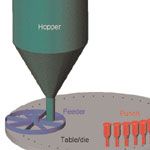
Freeman Technology
Tablet production demands the transformation of a relatively free-flowing powder into a compressed solid form. Stability is a defining performance characteristic, but rapid dissolution is also essential for efficient in vivo delivery. Other properties such as taste, smoothness, and shape must also be taken into account. As a result, tablets are complex multicomponent blends of binders, glidants, lubricants, disintegrants, sweeteners, flavors, pigments and, of course, active pharmaceutical ingredients (APIs).
Tableting has a long history, and substantial experience has been gained over many decades. Processors and formulators have traditionally relied heavily on this experience, taking an empirical, as opposed to knowledge-based, approach. Now, with the introduction of quality by design, the situation is changing. There is recognition of the importance of more fundamental knowledge and of investing heavily in its development.
Taking tableting as an example unit operation, this article explores how modern powder characterization techniques can provide valuable information that enhances understanding. Measuring dynamic, bulk, and shear properties of powders allows identification of the parameters that best define product performance, both during processing and in final application. This knowledge underpins fast, successful formulation development and effective process control.
The demands of the tableting process
Direct-compression tableting is a common method of solid dosage form manufacture. With this approach, the constituents of the tablet are blended and are then fed directly to the press. In most cases, however, the formulation cannot be used without first completing several preprocessing steps such as a wet or dry granulation. Granulating the blend reduces problems such as segregation and improves flow behavior by densifying and increasing the size of "particles."
Figure 1 shows a schematic of a single-sided rotary tablet press. Powder flows from the hopper or intermediate bulk container, down the transfer chute, and onto the table. The blend is distributed through the feeder and flows gravimetrically into the die. As the table rotates, excess powder is scraped away from the top of the die before the punches apply compression to create the tablet. The tablets are ejected before the dies reach the filling point again.
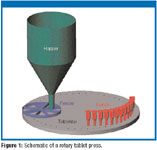
Figure 1
Because the aim is to produce tablets of defined weight, geometry, hardness, and composition, consistent flow from the hopper onto the table and through the feeder into the die is necessary. A free-flowing powder may avoid blockages and intermittent flow, but it also may be more prone to flooding or segregation (the separation of dissimilar-sized particles).
During the compression stage, the goal is to produce a stable form that can be cleanly ejected from the press with minimal force. Achieving this objective makes other aspects of powder behavior important. For example, if excess air is retained in the die and compressed along with the powder, then it may expand once the compression force is removed, causing the tablet to burst or cap. Blends that release air relatively easily are therefore preferred. Tablet strength also is directly affected by cohesivity—compressive strength. A blend with low cohesivity may form a weak, unstable tablet, while highly cohesive materials may adhere to the tablet press and cause variability in fill weight.
This brief analysis highlights some of the compromises involved in addressing just a few of the issues connected with processing and final product quality. Other performance criteria overlay additional and often conflicting priorities. For example, fines may be attractive to a formulator because they help achieve rapid dissolution and increase tablet-compression strength but are problematic during processing because they increase the risk of cohesive behavior and affect productivity. Balancing these variables is the formulator's art.
Experience-based formulation is possible, and indeed still common, but greater emphasis on effective processing and early definition of the design space is reducing the scope for error. Formulators need tools that provide relevant data at an early stage, thereby allowing rationalization of experience in terms of quantifiable parameters. This result gives insight and understanding, promoting a knowledge-based approach. Processors too require data to understand the reasons for both good and poor performance at the press. Such knowledge feeds back into formulation development and facilitates the successful processing of challenging blends.
Characterizing powders
It is no coincidence that the majority of powder processors share with tablet producers a heavy reliance on experience-based manufacture. Powders are challenging materials to characterize because their behavior depends on so many variables, including the properties of the particles themselves (e.g., hardness, porosity, size, shape, surface texture) and system variables such as air content and humidity, for example.
The complexity of powders makes a first-principles analysis of behavior beyond our current capabilities and severely challenges the relevance of single-number characterization. A more robust approach is to measure powders using reproducible methodologies that quantify certain aspects of behavior in process-relevant ways. Relating the resulting data to product performance allows the specification of powders that will perform in the required way in a given process environment.
A visual comparison of two different types of lactose—one spray dried, the other finely milled—provides a qualitative evaluation of flow behavior. Spray-dried lactose, with relatively large spherical particles, moves easily around a jar. The finely milled sample, with smaller angular particles, forms agglomerates, and its flow is more erratic. The finely milled sample is highly cohesive, but the spray-dried sample is not.
Simply pouring these samples into a vessel or funnel confirms these observations. Nonetheless, if attempts are made to force the powders through an orifice (with a diameter significantly larger than the particle size of the materials), then behavior is markedly different. Under these conditions, the finely milled lactose will extrude through the orifice like a paste, and the spray-dried lactose will tend to resist this forced flow. Selecting a lactose with good flow properties may not be the straightforward task it initially appears.
Table I shows a selection of shear and dynamic parameters for both samples. Shear properties are determined by measuring the stresses required to rotate one plane of a (usually) consolidated sample against another. Dynamic characterization, on the other hand, involves measurement of the forces and torques required to maintain a specified flow pattern under various test conditions. With dynamic instruments (e.g., powder rheometers), samples can be measured in an aerated state, giving information for a broad range of applications. Comprehensive details of testing methodologies are provided in Reference 1.
Finely milled lactose is usually cohesive; that is, the particles stick to one another and to other surfaces such as container walls, thus inhibiting consistent flow. Shear testing measures parameters such as cohesion and unconfined yield strength, thereby quantifying the higher cohesive strength of the finely milled lactose. Here, though, the focus is flow, so which parameters define flow behavior rather than the more general parameter of cohesivity?
Specific energy (SE) is a flow parameter measured under noncompacting conditions by rotating a rheometer blade upward through an unconfined sample. Like most dynamic properties, it is measured using a conditioned sample—one that has been prepared by being made to flow in a low-stress manner to establish a homogenized, slightly aerated, bed of powder. Conditioning before the measurement ensures a consistent baseline state, essentially eliminating any effects associated with sample loading or processing history such as previous levels of consolidation. The conditioning step is essential to ensure the best possible reproducibility. The SE for the spray-dried lactose is much lower than that for the finely milled sample, which indicates that it will flow more readily when unconfined and when the flow is initiated by gravity, such as when tumbling in a jar or flowing into a die during tablet manufacture.
By contrast, basic flow energy (BFE) is measured by pushing a rheometer blade down through a sample, thereby inducing compaction against the base of the vessel (confined flow). BFE values are highly differentiating and in this case clearly demonstrate that finely milled lactose will be superior in a confined forced flow processing (see Table I). Other measurements clarify the reasons for this apparent reversal in relative flow behavior.

Table I: Bulk, shear, and dynamic parameters for a spray-dried lactose and finely milled lactose.
The compressibility of the finely milled lactose is much higher than that of the spray-dried sample. In this case, compressibility was defined as the change in bulk density induced through the application of a normal stress (<20 kPa). In general, finer cohesive materials tend to have a higher porosity or air content, so compression has a marked effect, forcing out air and increasing bulk density. Conversely, the spray-dried lactose has minimal cohesion and in its conditioned low-stress state, packs efficiently. The gravitational forces acting on each particle exceed the cohesive forces between them and thus minimizes the number of void spaces in the powder. The result is a stiff powder bed for which density changes little as a result of compression.
These differences in compressibility provide a rationalization of the measured BFE values. With the finely milled lactose, the compacting motion of the blade generates only localized compression and the flow zone is relatively small. The spray-dried sample, on the other hand, does not easily compress, so the compacting force is transmitted through the sample. A large flow zone is created with many particles in motion simultaneously, thereby resulting in a high BFE.
It is clear that flow behavior can vary and can be characterized in different ways, even when complicating factors such as aeration, consolidation, and humidity are not considered in any detail. Powders are not intrinsically good or bad, but it is the match between material and process that is crucial. The key to successful formulation and processing is identifying and controlling the parameters that define performance for any given application. This information is uncovered by correlating various powder properties with experience from the existing skill base or experimental work. The following examples highlight correlations between measurable parameters and aspects of tableting.
Optimizing flow-additive concentration
Flow additives such as colloidal fumed silica and magnesium stearate are widely used to improve the flow properties of a blend. An incorrect level of flow additive can be detrimental, with too little producing suboptimal flow and too much promoting lamination of the final tablet. It is understood that lamination, breakage along a plane, occurs when flow additive separates into a layer within the tablet, a process accentuated by high additive levels. Optimizing additive concentration is therefore important.
Figure 2 shows how BFE varies with flow-additive concentration for two different blends that exhibit markedly different behavior. BFE is an extremely sensitive detector of differences in flow behavior and therefore ideal for this type of study. With sample 1, BFE passes through a minimum where there is clearly an optimum concentration. With the second sample, the optimal level may be similar, but it is clear that low additive concentrations have little effect.

Figure 2
Particle morphology can be a dominating factor in terms of how a material responds to a flow additive (see Figure 3). The relatively smooth particles (A to D) will exhibit the behavior shown by sample 1. As flow-additive levels increase, the large particles become more uniformly coated with the smaller lubricating particles, and flow energy decreases steadily. Once all surfaces are coated, excess additive builds in the void spaces, resulting in mechanical interlocking and increased cohesion, hence flow energy begins to increase again.
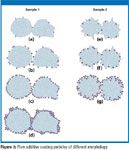
Figure 3
The irregularly shaped particles (E to G) are initially unaffected by the inclusion of additive because the small particles are unable to provide an effective lubricating effect. Only when sufficient additive has been added to lubricate the contact points between the larger particles is a rapid reduction in flow energy observed (sample 2).
Assessing the likelihood of flooding
Flooding describes the uncontrolled flow of aerated powder, which can be hazardous and is mostly undesirable. Aeration plays an instrumental role in flooding because the air between the particles acts as a lubricant and inhibits the mechanical interlocking that would normally result in a stable bed. Flooding is common with fine but noncohesive materials that easily pick up and retain air.
It is clear that when flooding occurs, little energy is required to make the powder flow. Consequently, measuring flow energy under aerated conditions is effective in highlighting possible problems. Figure 4 shows flow energy as a function of air velocity for two different materials. Measuring the affect of aeration is simple with a powder rheometer because air can be fed at a controlled velocity through the sintered base, up into the powder sample, during testing.
The flow energy of sample A falls markedly with aeration, and that of sample B remains relatively unchanged (see Figure 4). This decrease in flow energy with increasing aeration is symptomatic of noncohesive powders that are prone to flooding and is particularly problematic when combined with a low BFE. Generally speaking, powders with an aerated flow energy ,10 mJ are more likely to fluidize and flood.

Figure 4
Although it is tempting to suggest that flooding is avoided by preventing aeration, this is not a practical proposition because air content cannot be precisely controlled during processing. Powders can easily pick up air, for example during blending or emptying from a keg.
Characterizing deaeration behavior
Although a degree of aeration is beneficial because it encourages continuous flow through the press, it is desirable that any entrained air is released easily as the powder settles in the die and is compressed. This release of air enhances dose-weight consistency and prevents tablet breakage that may occur when compressed air is released upon ejection of the tablet from the press.
Figure 5 shows the deaeration characteristics of three different lactose samples. Once the air supply has been removed, it is clear that both the spray-dried and coarsely milled lactose rapidly release air, and flow energy returns to stable, conditioned values quickly. The finely milled lactose, on the other hand, deaerates much more slowly because the air takes longer to permeate out from the powder bulk. These data correlate directly with the likelihood of tablet capping as a result of air release postcompression.
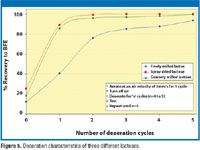
Figure 5
Optimizing compressive strength
A process closely related to direct-compression tableting is the production of compacts for blister filling. Like tableting, this process involves die-filling and subsequent compression of a dose. The compressing force, however, is much less: around 10 kPa rather than the MPa stresses used for tableting.
For this process, an optimum level of cohesion and other mechanical properties are required to form stable compacts or plugs under the application of moderate compressive force. Excessively cohesive materials adhere to the punches, thus compromising dose uniformity and production rates. Figure 6 shows measurements made during an experimental investigation of the effect of flow additive on the properties of a pharmaceutical blend.
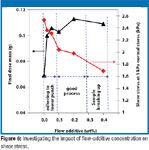
Figure 6
As the concentration of flow additive rises, compressive strength (as measured by shear stress) falls. Initially the material is so cohesive that it adheres to the punches during compression. As compressive strength falls, there is a range over which good-quality compacts are produced, but then, below a certain compressive strength, the compacts fall apart upon ejection. The optimal compressive-strength range is clear.
The way forward
The pressures on the pharmaceutical industry are catalyzing change. Designing quality into the product and manufacturing process (quality by design), monitoring and controlling processes to consistently produce the correct material (process analytical technology), and the long-term trend toward continuous processing are all evidence that the sector recognizes the need to work more efficiently. The success of such approaches ultimately rests on the development of better understanding.
Although powders present a challenge to the formulator and processor, modern powder-characterization techniques have much to contribute. Correlating various powder properties—shear, bulk, and dynamic—with product performance or processing behavior develops understanding of the properties that are critical for a given application. This approach allows experience to be quantified in terms of parameters that can be measured reproducibly. The experience that A processes well while B is much worse can be converted into knowledge that A processes better than B because it has a BFE in the range x to y, a compressive strength of z, and deaerates after only two deaeration cycles. The approach remains to some extent empirical, but it is vastly superior to development and operation that depend solely on experience.
State-of-the-art powder testers offer a suite of testing methodologies in a single instrument, thus providing access to the necessary data. The information opens up a route to better understanding and the development of transferable knowledge. These systems have an important role to play in helping the pharmaceutical industry conquer the complexities of powder processing and more effectively develop new products.
Tim Freeman is the director of operations at Freeman Technology, Boulters Farm Centre, Castlemorton Common, Welland, Worcestershire, WR13 6LE, UK, tel. 144 1684 310860, fax 144 1684 310236, www.freemantech.co.uk
Reference
R. Freeman, "Measuring the Flow Properties of Consolidated, Conditioned, and Aerated Powders—A Comparative Study Using a Powder Rheometer and a Rotational Shear Cell," Powder Technol. 174, 25–33, (2007).
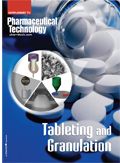
PacBio Chosen as Tech Partner for Global Alzheimer’s Disease Research Project
April 23rd 2025The project, the North African Dementia Registry, will unite multiple entities for the purpose of developing a comprehensive dataset to advance the research community’s understanding of Alzheimer’s disease and other dementias in diverse populations.
Drug Solutions Podcast: A Closer Look at mRNA in Oncology and Vaccines
April 30th 2024In this episode fo the Drug Solutions Podcast, etherna’s vice-president of Technology and Innovation, Stefaan De Koker, discusses the merits and challenges of using mRNA as the foundation for therapeutics in oncology as well as for vaccines.